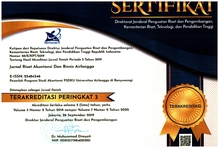FINANCIAL LITERACY LECTURER IN SOUTH TANGERANG : SOCIOECONOMIC DETERMINANTS AND DEMOGRAPHIC FACTORS
Downloads
The purpose of this study is to measure and test the influence of socioeconomic and demographic factors on improving financial literacy in lecturers in South Tangerang City. This type of research uses quantitative research with survey methods. The population is all college lecturers in South Tangerang city asmany as 5,974 respondents andthe sample number of 209 respondents with simple random sampling method. The data sources used are primary and secondary data. The data analysis method used is multiple regression with SPSS version 25. The results found that socioeconomic influence is positive and significant to financial literacy. Variable demographic factors have a positive and significant effect on financial literacy. The results of this study contribute to the field of financial accounting, especially related to socioeconomic factors, demographics and financial literacy that can provide information and input sources for the government, OJKcommunity in helping to improve knowledge and understanding of financial services products as a form of improving financial literacy and needed from various parties especially from the academics of universities who can contribute to the development of theory and study of libraries
Downloads
Adi, F., Sumarwan, U., & Fahmi, I. (2017). Literasi Keuangan Syariah dan Konvensional terhadap Minat Berwirausaha pada Mahasiswa. Jurnal Al-Muzara`ah, 5(1), 1–20.
Akdon, & Riduwan. (2013). Rumus dan Data Dalam Analisis Statistika. Alfabeta. Bandung.
Arianti, B. F. (2018). The Influence of Financial Literacy, Financial Behavior and Income on Investment Decision. Economics and Accounting Journal, 1 (1), 1-10
Arianti, B. F. (2020). Pengaruh Pendapatan Dan Perilaku Keuangan Terhadap Literasi Keuangan Melalui Keputusan Berinvestasi Sebagai Variabel Intervening. Jurnal Akuntansi, 10(1), 13–36. https://doi.org/10.33369/j.akuntansi.10.1.13-36
Ansong, A., & Gyensare, M. A. (2012). Determinants of University Working-Students' Financial Literacy at the University of Cape Coast, Ghana. International Journal of Business and Management, 7(9), 126–133. https://doi.org/10.5539/ijbm.v7n9p126
ANZ Banking Group. (2015). ANZ Survey of Adult Financial Literacy in Australia. May, 182. http://www.anz.com/Documents/AU/Aboutanz/AN_5654_Adult_Fin_Lit_Report_08_Web_Report_full.pdf
Bhushan, P., & Medury, Y. (2013). Financial Literacy and its Determinants. International Association of Scientific Innovation and Research, 4(2), 155–160.
Das, S. (2016). Financial literacy : measurement and determinants. EPRA International Journal of Economic and Business Review, 509(June), 88–93. http://eprawisdom.com/jpanel/upload/articles/104pm11.Sanjib.pdf
Humaira, I., & Sagoro, E. M. (2018). Pengaruh Pengetahuan Keuangan, Sikap Keuangan, Dan Kepribadian Terhadap Perilaku Manajemen Keuangan Pada Pelaku Umkm Sentra Kerajinan Batik Kabupaten Bantul. Nominal, Barometer Riset Akuntansi Dan Manajemen, 7(1). https://doi.org/10.21831/nominal.v7i1.19363
Irman, M., & Fadrul, F. (2018). Analisis Pengaruh Jenis Kelamin, IPK, dan Pengalaman Kerja terhadap Tingkat Financial Literacy. Journal of Economic, Bussines and Accounting (COSTING), 2(1), 41–56. https://doi.org/10.31539/costing.v2i1.345
KHOTIMAH, K., & ISBANAH, Y. (2018). Demografi, Faktor Individu, Dan Literasi Keuangan Wanita Karir Di Surabaya. Jurnal Ilmu Manajemen (JIM), 7(2).
Laxmi, V., & Maheshwary, N. K. (2018). Identification of Factors Influencing Financial Literacy : A Theoretical Review. International Journal of Research in Management, Economics and Commerce, 08(1), 89–94.
Margaretha, F., & Pambudhi, R. A. (2015). Tingkat Literasi Keuangan Pada Mahasiswa S-1. Tingkat Literasi Keuangan Pada Mahasiswa S-1 Fakultas Ekonomi, 17(1), 76–85. https://doi.org/10.9744/jmk.17.1.76
Mitchell, O. S., Lusardi, A., & Curto, V. (2011). Financial Literacy Among the Young: Evidence and Implications for Consumer Policy. SSRN Electronic Journal, 1–35. https://doi.org/10.2139/ssrn.1459141
Otoritas Jasa Keuangan. (2016). Survei Nasional Literasi dan Inklusi Keuangan 2016 (National Literacy and Financial Inclusion Survey 2016). Survey Report, 1–26. www.ojk.go.id
OJK. (2017). Strategi Nasional Literasi Keuangan Indonesia (Revisit 2017). Otoritas Jasa Keuangan, 1–99.
Mandala, I. G. N. N., & Wiagustini, L. P. (2017). Pengaruh Variabel Sosial Ekonomi, Demografi, dan IPK Terhadap Financial Literacy. E-Jurnal Ekonomi Dan Bisnis Universitas Udayana, 12(6), 4225–4254.
Natoli, R. (2018), "Factors contributing to financial literacy levels among a migrant group: An analysis of the Vietnamese cohort", International Journal of Social Economics, Vol. 45 No. 5, pp. 730-745. https://doi.org/10.1108/IJSE-11-2016-0341
Nurhidayati, S., & Anwar, M. (2018). Pengaruh Faktor Demografi Terhadap Literasi Keuangan Syariah Karyawan Perbankan Syariah di Surabaya. Jurnal Ekonomi Islam, 1(1), 1–11.
Romadoni, R. (2017). Pengaruh Status Sosial Ekonomi Dan Pendidikan Pengelolaan Keuangan Di Keluarga Terhadap Literasi Keuangan Siswa Smk Negeri 1 Surabaya. Jurnal Ekonomi Pendidikan Dan Kewirausahaan, 3(1), 22. https://doi.org/10.26740/jepk.v3n1.p22-34
Remund, D. L. (2010). Financial literacy explicated: The case for a clearer definition in an increasingly complex economy. Journal of Consumer Affairs, 44(2), 276–295. https://doi.org/10.1111/j.1745-6606.2010.01169.x
Sabri, Fazli, M. (2011). Pathways to financial success : Determinants of financial literacy and financial well-being among young adults Digital Repository @ Iowa State University Pathways to financial success : Determinants of financial literacy and financial well-being among you. January 2011.
Suryanto, S., & Rasmini, M. (2018). Analisis Literasi Keuangan Dan Faktor-Faktor Yang Mempengaruhinya. Jurnal Ilmu Politik Dan Komunikasi, 8(2). https://doi.org/10.34010/jipsi.v8i2.1336
Salleh, A. M. H. A. P. M. (2015). A comparison on financial literacy between welfare recipients and non-welfare recipients in Brunei. International Journal of Social Economics, 42(7), 598–613. https://doi.org/10.1108/IJSE-09-2013-0210
Soejono, F., & Mendari, A. S. (2018). Literasi Keuangan Dosen-Dosen Perguruan Tinggi di Palembang: Faktor Gender dan Usia. Benefit: Jurnal Manajemen Dan Bisnis, 3(1), 74. https://doi.org/10.23917/benefit.v3i1.6181
Sugiyono. (2013). Metode Penelitian Kualitatif, Kuantitatif dan R&D. Alfabeta. Bandung.
Susanti, A. (2017). Tingkat Pendidikan, Literasi Keuangan, Dan. Telaah Bisnis, 18(1), 45–56.
Stolper, O. A., & Walter, A. (2017). Financial literacy, financial advice, and financial behavior. Journal of Business Economics, 87(5), 581–643. https://doi.org/10.1007/s11573-017-0853-9
Thomas, B., & Subhashree, P. (2020). Factors that influence the financial literacy among engineering students. Procedia Computer Science, 172(2019), 480–487. https://doi.org/10.1016/j.procs.2020.05.161
Walt, F. Van Der. (2017). Financial Literacy of Undergraduate Students – a Case Study of a Public University in South Africa. International Journal of Economics and Finance Studies, 9(2), 48–65.
Wardani, E. W., Susilaningsih, & Sangka, K. B. (2017). Faktor-Faktor yang Mempegaruhi Literasi Keuangan Mahasiswa Program Studi Pendidikan Akuntansi Fakultas Keguruan dan Ilmu Pendidikan Universitas Sebelas Maret. Jurnal "Tata Arta” UNS, 3(3), 80–93.
Widayati, I. (2014). Pengaruh Status Sosial Ekonomi Orang Tua, Pendidikan Pengelolaan Keuangan Keluarga, dan Pembelajaran di Perguruan Tinggi terhadap Literasi Finansial Mahasiswa. Jurnal Pendidikan Humaniora, 2, No. 2(2), 176-183j.
Copyright (c) 2020 Baiq Fitri Arianti, Yunita Kurnia Shanti, Julian Maradina

This work is licensed under a Creative Commons Attribution-ShareAlike 4.0 International License.

























